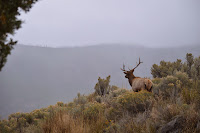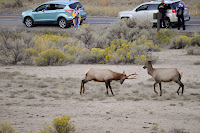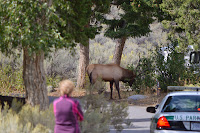*Birds we’ve seen on our 2013
trip so far: osprey, pheasant, magpie, raven, Canada
geese, mountain bluebird, grouse, golden eagle, bald eagle, American avocet,
sandhill crane, red-tailed hawk, cliff swallow, northern flicker, Clark ’s nutcracker, Brewer’s blackbird
[Click on any
photo to enlarge.]
Fall is the time of year when it cools down and the bull elk make their
way down from the higher elevations because it’s mating season! Known as the rut, they gather together as many
cows and calves as they can to create their “harem” and will aggressively
defend the group against intruders
 by chasing the other bulls, thrashing their
antlers against the ground and trees, and
head butting and antler wrestling each other if neither bull backs down. Sometimes they will even ram cars parked
nearby. One of the bulls this year took
out the rear passenger window of a ranger’s car!
by chasing the other bulls, thrashing their
antlers against the ground and trees, and
head butting and antler wrestling each other if neither bull backs down. Sometimes they will even ram cars parked
nearby. One of the bulls this year took
out the rear passenger window of a ranger’s car!
The size and configuration of the
bull’s rack is a sign of his quality and virility to the cows. To appear more impressive, they will also
wallow in the mud and urinate on themselves as a “perfume” to attract more
cows. Some of these guys never seem to
think they
 have enough and will actually leave their harem unattended and head
down the hill to gather up a couple more…kind of a risky venture on their part! Younger, immature bulls try to get in on the
action but usually are not very successful.
have enough and will actually leave their harem unattended and head
down the hill to gather up a couple more…kind of a risky venture on their part! Younger, immature bulls try to get in on the
action but usually are not very successful.
You generally know when the rut has
begun because the bulls begin to bugle which not only announces their presence
to other males but also gives a cow clues to his size and strength (key factors
she wants to impart to her offspring).
 The
vocal range of the bugle varies with the individual and their maturity
level. It can be heard for miles and is
one of the most amazing and distinctive sounds.
The
vocal range of the bugle varies with the individual and their maturity
level. It can be heard for miles and is
one of the most amazing and distinctive sounds.
- Young bulls (about a year old) are called spikes mainly because of their single antlers that usually have no branches.
- When threatened, an elk will strike out with their forefeet.
- Growing antlers, which are shed each spring, are covered in soft skin full of blood called velvet and is removed each fall by rubbing them on shrubs and trees.

2 comments:
Awesome photos. Thanks for posting
Wow, did not know urinating on oneself was attractive to females! Kelly
Post a Comment